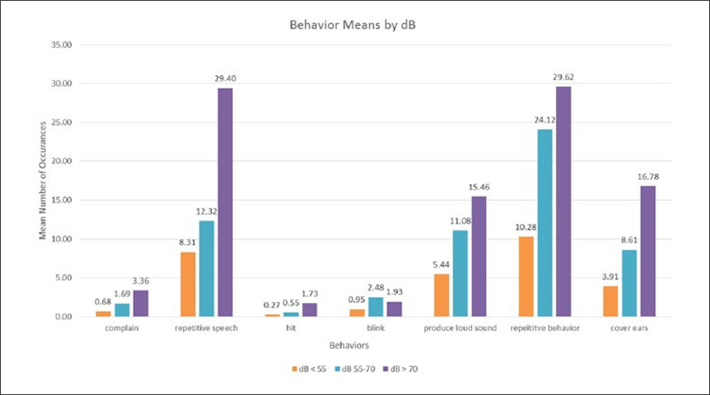
The has been a lack research focusing on which facets of the indoor environment should be impacting ASD students’ behavior. Especially regarding the acoustics impact on children with Autism.
“A lot of research has been conducted around children with Autism Spectrum Disorder (ASD), but little has been available that has focused on facets of the environment that could be impacting their behavior. In previous studies [1, 2], I have explored this relationship between classroom ambient noise levels and the presence of repetitive behaviors in these children and evidence of a correlation between the two was found. My results revealed that as decibel levels increased, so did the frequency of the observed repetitive behaviors. These findings are shown in more detail in the depicted graph where the louder rooms brought about higher frequencies of the children complaining, engaging in repetitive speech, hitting, producing loud sounds, and covering their ears. Eager to gain a deeper understanding of this relationship, I set out to create an environment suitable for my studies.” says
researcher, Shireen Mohammad Kanakri, PHD, AIA associate (Associate Professor of Interior Design)

The Research Lab provides a controlled environment for acoustic studies
The Health and Environmental Design Research Lab at Ball State University houses my controlled environment for analyzing acoustics and its impact on children with ASD. It consists of a play area, a sound proof room, and an observation station. It’s an environment that the children typically feel very comfortable in due to its sound-controlled qualities and I receive a lot of positive feedback from the parents. Here I am able to test a variety of environmental factors, but lately, my focus has been on acoustics.

Different sound levels influence both the childrens’ observable behaviours and physiological reactions
In my quest to learn more about the relationship between acoustics and autism, I have been researching how various sound decibel levels influence both the observable behaviors and physiological reactions of the children. I am able to expose them to a specific sound, observe any reactions, and record physiological evidence all at once.
In addition to sound we recorded their heart rate, respiration rate and ECG readings
My most recent study tested children between the ages of 2 and 9 and recorded their reactions to 40dB, 55dB, and 70dB levels. We gave the children a specific task and observed their physical reactions during the experimental sessions while simultaneously recording their heart rate, respiration rate, and ECG readings.
We divided our findings into the observed behavioral results and the physiological results
- From a behavioral view, the children managed to stay on task for a majority of the time, but when it came to the 70dB sound levels, there was a higher degree of variation in the total behaviors that we were seeing. We were also seeing a higher level of mental disengagement at this point.
- Physiologically, instead of seeing a generalized theme or correlation develop between increasing decibel levels and biological reactions, we found that a predictive mechanism was being developed. We discovered that we would be able to predict the behavior of the child if we had accounted for the acoustic level exposure as well as the physiological reading such as heart rate, respiratory rate, or ECG variance.
Direction for future research around acoustics impact on children with Autism and ASD in general
“This knowledge could be extremely valuable for future sound studies surrounding the environment and ASD and we hope it generates more outcomes in designing universally acceptable spaces for these children.” says Shireen.
For more detailed results and information regarding this study, be on the lookout for a formal published piece in Environment and Behavior here soon!
Email Shireen Mohammad Kanakri, PHD, AIA associate here or visit the Department of Construction management and Interior Design website here.
This study was referenced in our recent publication “The impact of noise in education – a research summary”. Please see more about the summary in a previous post here.
References:
1. Kanakri, S. M., Shepley, M., Tassinary, L. G., Varni, J. W., & Fawaz, H. M. (2017). An observational study of classroom acoustical design and repetitive behaviors in children with autism. Environment and Behavior, 49(8), 847-873.
2. Kanakri, S. M., Shepley, M., Varni, J. W., & Tassinary, L. G. (2017). Noise and autism spectrum disorder in children: An exploratory survey. Research in developmental disabilities, 63, 85-94.
Title image: Reprinted from “An observational study of classroom acoustical design and repetitive behaviors in children with autism”, by Kanakri, S., Environment and Behavior, 49, p. 866.

